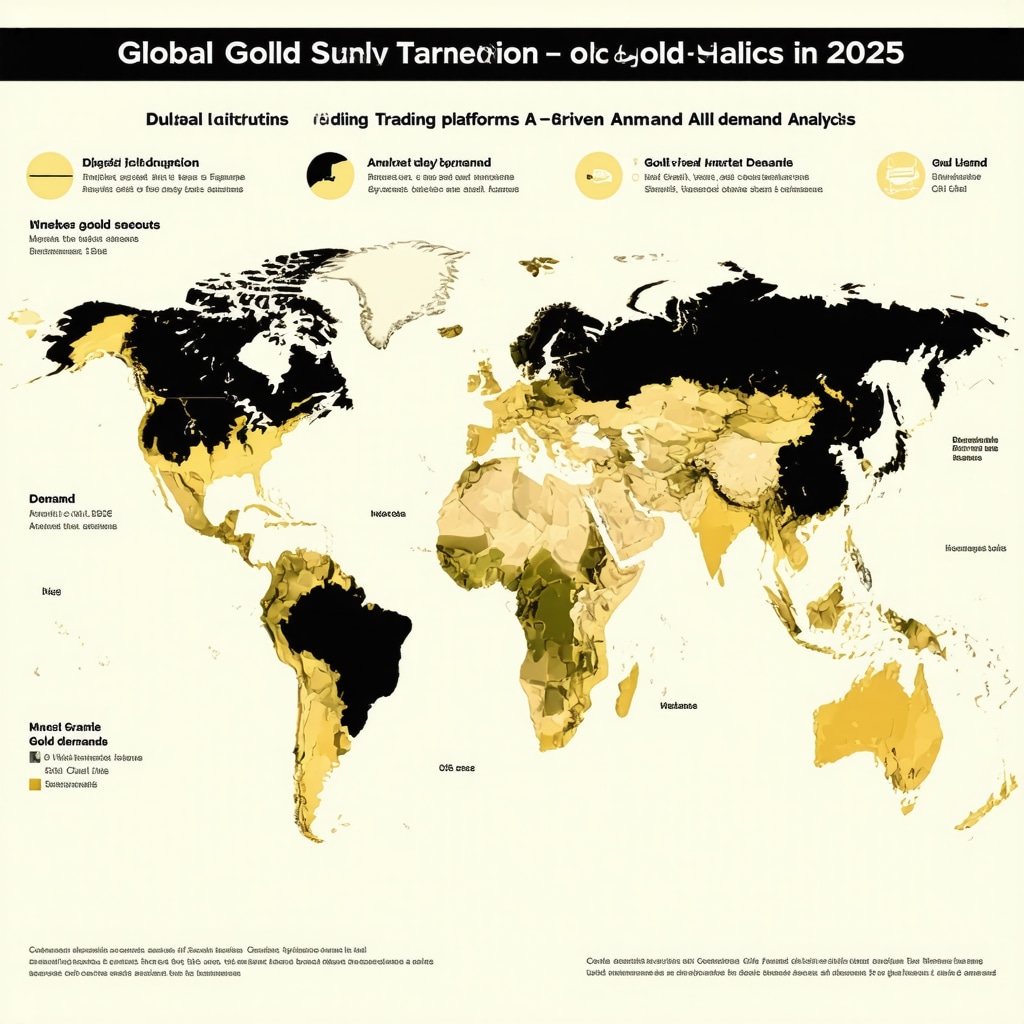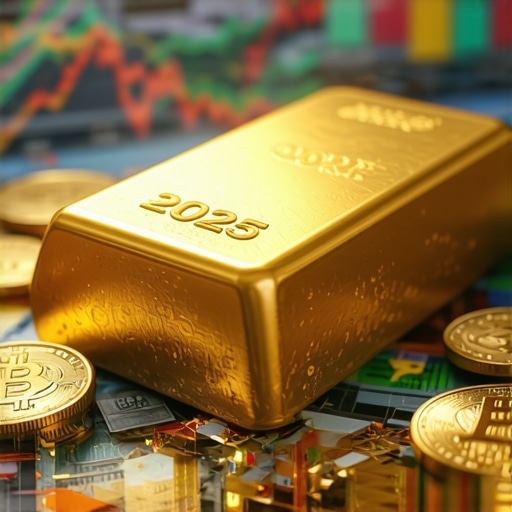Unveiling the Dynamic Pulse of Global Gold Demand
In an era marked by geopolitical shifts, inflationary pressures, and evolving consumer preferences, the global demand for gold is undergoing transformative changes. For investors, understanding these demand trends is not just an academic exercise but a crucial compass guiding sophisticated portfolio strategies. Gold, long revered as a safe haven and store of value, now faces nuanced influences from emerging markets, central banks, and technological innovation that collectively reshape its investment appeal.
Emerging Markets: The New Powerhouses Driving Gold Appetite
Asia, particularly countries like India and China, continues to dominate gold consumption, fueled by cultural affinity and rising wealth. In tandem, burgeoning economies across Africa and the Middle East are witnessing increased demand for physical gold, both as jewelry and investment. This shift is reshaping supply chains and creating fresh investment opportunities, urging investors to consider geographic demand patterns critically when allocating assets. For a deep dive into these patterns, this analysis of gold demand trends in Asia offers valuable insights.
Central Banks’ Strategic Gold Accumulation: What It Means for Investors
Global central banks have ramped up gold purchases as a hedge against currency volatility and geopolitical uncertainty. These official reserves act as a powerful indicator of market confidence and liquidity conditions. Investors observing these trends can anticipate shifts in gold prices driven by macroeconomic policy moves. Understanding how central bank gold acquisitions influence market dynamics is crucial for crafting resilient investment strategies. Explore more on this topic in how central bank gold purchases shape market trends.
How Do Fluctuations in Global Gold Demand Affect Investment Timing and Portfolio Allocation?
The interplay between fluctuating gold demand and price volatility presents both challenges and opportunities for investors. When demand surges due to inflation fears or geopolitical crises, gold prices often spike, prompting timely portfolio rebalancing. Conversely, periods of muted demand may encourage diversification into gold mining stocks or ETFs rather than physical bullion. Seasoned investors leverage these demand cycles, blending physical gold, mining equities, and financial derivatives to optimize risk-adjusted returns.
Technological and Demographic Shifts Redefining Gold Investment Strategies
Advancements in digital gold trading platforms and the rise of gold-backed ETFs have democratized access, enabling smaller investors to participate efficiently. Meanwhile, younger generations show growing interest in gold as part of sustainable and diversified portfolios, often guided by data analytics and real-time market intelligence. These trends highlight the need for agile investment strategies that incorporate both traditional gold assets and innovative financial instruments.
For investors seeking expert guidance, effective gold investment strategies to grow your wealth in 2025 provide actionable frameworks tailored to current market realities.
Engage with this evolving topic: share your thoughts or experiences on how global gold demand trends have influenced your investment approach in the comments below.
Authoritative insights on global gold demand trends and their implications for investors can be further explored through the World Gold Council’s comprehensive reports, a cornerstone resource for market participants seeking verified and timely data.
Gold Supply Constraints and Their Impact on Market Equilibrium
While demand dynamics are pivotal, supply-side factors equally influence gold’s market behavior. Mining output fluctuations, geopolitical risks in key producing regions, and rising extraction costs can constrain supply, intensifying price volatility. Investors must monitor mining production reports and geopolitical developments closely to anticipate supply shortages that could catalyze price rallies. For example, disruptions in South Africa or Russia’s mining sectors often reverberate significantly through global gold markets.
Integrating Gold Demand Analytics into Portfolio Risk Management
Advanced investors deploy quantitative models that incorporate gold demand trends alongside macroeconomic indicators such as inflation rates, currency strength, and interest rate trajectories. This multi-factor approach enables more precise timing for inflows and outflows in gold-related assets, balancing liquidity needs with risk mitigation. The nuanced interpretation of demand signals—distinguishing between jewelry demand surges and central bank acquisitions—further refines portfolio adjustments to current market conditions.
Can Emerging Digital Gold Trading Platforms Revolutionize Investor Access and Market Efficiency?
The surge in digital platforms offering fractional gold ownership and gold-backed tokens raises vital questions about market accessibility and liquidity. These innovations promise democratization but also introduce regulatory uncertainties and cybersecurity risks. Investors must evaluate platform credibility, asset custody protocols, and underlying gold backing to safeguard their investments. According to the World Gold Council, digital gold demand is gaining traction, especially among younger demographics, signaling a paradigm shift in how gold is bought and held globally.
For those interested in maximizing their gold investment returns while navigating complex market forces, exploring effective gold investment strategies to grow your wealth in 2025 can provide actionable insights. Engage with this expert discourse by sharing your perspectives or questions about evolving gold demand trends in the comments below.
Decoding the Ripple Effects of Gold Supply Disruptions on Global Market Stability
Supply-side shocks in the gold market, often triggered by geopolitical instability or operational challenges within dominant mining regions, create complex ripple effects that extend beyond immediate price fluctuations. For instance, when a key mining hub like South Africa faces labor strikes or regulatory clampdowns, the resultant production shortfall not only tightens physical supply but also heightens market uncertainty, leading to speculative trading and amplified volatility.
Moreover, rising extraction costs driven by deeper ore bodies and environmental regulations contribute to a structural tightening of supply. This can incentivize mining companies to delay investment or exploration, thereby constraining future supply potential. Investors with a tactical edge monitor these upstream industry signals using data-heavy mining output reports and real-time geopolitical risk assessments, enabling preemptive portfolio adjustments before market prices reflect these constraints.
How Can Sophisticated Investors Quantify and Incorporate Gold Supply Risk into Portfolio Models?
Incorporating supply risk into portfolio management transcends simple price tracking. Quantitative frameworks employ probabilistic models that factor in mining production variance, geopolitical risk indices, and cost inflation forecasts. For example, Value-at-Risk (VaR) models augmented with supply disruption scenarios allow investors to estimate potential drawdowns associated with gold scarcity events.
Additionally, scenario analysis tools simulate outcomes of mine closures or sanction-induced export restrictions, providing a nuanced understanding of tail risks. These techniques empower portfolio managers to hedge appropriately through strategic allocation to gold derivatives or geographically diversified mining equities, thereby mitigating adverse supply shocks.
Digital Gold Trading Platforms: Catalysts for Democratization and Market Efficiency
The emergence of blockchain-enabled gold tokens and fractional ownership platforms is revolutionizing the traditional barriers to gold investment. These technologies enable near-instantaneous settlement, reduced transaction costs, and enhanced transparency regarding asset provenance and custody.
However, with innovation comes the imperative for rigorous due diligence. Investors must critically assess platform governance, security protocols, and regulatory compliance to avoid pitfalls such as counterparty risk or fraudulent schemes. Furthermore, the integration of smart contracts facilitates automated dividend distributions and ownership transfers, adding layers of sophistication previously unavailable in physical gold trading.
According to the World Gold Council, digital gold demand is especially pronounced among millennials and Gen Z investors, who favor liquidity and accessibility without sacrificing exposure to gold’s intrinsic value.

Leveraging Data Analytics and AI for Predictive Gold Demand Modeling
Cutting-edge investors are increasingly harnessing artificial intelligence and machine learning algorithms to parse vast datasets encompassing economic indicators, social sentiment, and even satellite imagery of mining activity. These predictive models offer unprecedented foresight into imminent gold demand shifts, allowing for proactive repositioning within portfolios.
For instance, natural language processing tools analyze geopolitical news flows to detect early warnings of conflict or policy changes that historically correlate with gold price spikes. Satellite data can reveal operational bottlenecks or expansions in mining regions, feeding into supply-side predictive analytics.
This fusion of big data and domain expertise represents the frontier of gold investment strategy, where quantitative rigor meets qualitative insight to optimize returns in a volatile global environment.
For investors committed to mastering this evolving landscape, exploring comprehensive resources such as effective gold investment strategies to grow your wealth in 2025 is highly recommended. We invite you to deepen this expert dialogue by sharing your questions or innovative approaches to gold demand analytics in the comments below.
Quantifying Supply Chain Vulnerabilities with Cutting-Edge Risk Metrics
Beyond traditional monitoring, the application of sophisticated risk quantification methods allows investors to dissect gold supply chain fragilities with greater precision. Techniques such as Monte Carlo simulations and stress testing against geopolitical scenarios provide probabilistic insights into potential supply disruptions. These methods enable portfolio managers to anticipate market shocks well before they materialize, refining hedging strategies with tactical allocation shifts into diversified mining equities or options-based instruments.
What Are the Emerging Best Practices for Incorporating Real-Time Supply Chain Data into Gold Investment Decisions?
Integrating real-time data streams, including satellite imagery, logistics tracking, and commodity shipment reports, is becoming a hallmark of advanced gold investment frameworks. By leveraging APIs from mining companies and trade platforms alongside AI-driven anomaly detection, investors can identify supply bottlenecks or unexpected production halts promptly. This immediacy supports dynamic portfolio rebalancing and risk mitigation. The Metals Focus, known for its authoritative mining and supply chain research, offers invaluable datasets that underpin such cutting-edge analysis.
Cryptographic Assurance and Compliance in Digital Gold Platforms
As digital gold platforms proliferate, ensuring cryptographic security and regulatory compliance is paramount for safeguarding investor assets. Innovations such as zero-knowledge proofs and blockchain immutability enhance transparency while preserving user privacy, setting new standards for trustworthiness. Compliance frameworks increasingly mandate rigorous audits and custodial segregation, elevating platform credibility. Investors versed in these technological safeguards can capitalize on the liquidity and fractional ownership benefits while minimizing counterparty risks.
Harnessing AI-Driven Sentiment Analysis to Forecast Gold Demand Surges
Artificial intelligence has transcended quantitative modeling by incorporating sentiment analysis from diverse data sources—social media, economic policy announcements, and global news feeds—to predict gold demand fluctuations. These models capture investor psychology nuances, often preceding traditional market indicators. Consequently, portfolio managers employing sentiment-driven signals can time entries and exits with heightened accuracy, optimizing returns amid volatile macroeconomic climates.
For practitioners eager to deepen their mastery, effective gold investment strategies to grow your wealth in 2025 remain an essential resource. Engage with this advanced discourse by contributing your insights or inquiries about integrating real-time analytics and digital innovations into gold investment approaches in the comments below.
Frequently Asked Questions (FAQ)
What factors primarily drive fluctuations in global gold demand?
Global gold demand is influenced by a confluence of factors including cultural preferences (notably in Asia), central bank reserve policies, macroeconomic conditions such as inflation and currency volatility, technological advancements like digital trading platforms, and geopolitical events that alter investor sentiment and supply chain stability.
How do central bank gold purchases impact gold prices and investment strategies?
Central banks accumulate gold to hedge against currency risks and geopolitical uncertainty, signaling market confidence levels. Their strategic buying often tightens supply and can drive price rallies. Investors monitor these purchases to anticipate market trends and adjust portfolio allocations towards physical gold or derivatives accordingly.
In what ways are emerging digital gold trading platforms transforming investor access?
Digital platforms enable fractional ownership, lower entry barriers, instant settlement, and enhanced transparency through blockchain technology. They democratize gold investment, especially among younger demographics, but also necessitate rigorous due diligence to mitigate regulatory, cybersecurity, and custody risks.
How can investors incorporate gold supply chain risks into their portfolio management?
Advanced investors use probabilistic models, scenario analysis, and real-time data streams (satellite imagery, logistics tracking) to quantify supply disruptions from geopolitical events or mining challenges. These insights inform hedging strategies, such as diversifying into mining equities or options, to mitigate supply-side risks.
What role does AI and data analytics play in predicting gold demand?
AI and machine learning analyze vast data sets including economic indicators, social sentiment, and geopolitical news to forecast demand shifts ahead of traditional signals. Sentiment analysis from social media and policy announcements helps time market entries and exits, optimizing investment returns amid volatility.
How do geopolitical events in key mining regions affect gold market stability?
Disruptions such as labor strikes, regulatory changes, or export sanctions in major producing countries constrict supply, leading to price volatility and speculative trading. These ripple effects necessitate vigilant monitoring and flexible portfolio rebalancing to manage risk effectively.
What should investors consider when evaluating the credibility of digital gold platforms?
Key considerations include platform governance, cryptographic security measures (e.g., zero-knowledge proofs), regulatory compliance, asset custody protocols, and transparency of gold backing. Ensuring these factors can protect against counterparty risk and fraud.
How do demographic shifts influence gold investment trends?
Younger investors increasingly favor accessible, liquid gold investment vehicles like ETFs and digital tokens, often driven by sustainability and diversification goals. This shift encourages innovation in product offerings and demands agile investment strategies.
Can gold demand analytics improve portfolio risk management?
Yes. Incorporating multi-factor quantitative models that blend demand data with macroeconomic indicators enables precise timing of gold asset inflows and outflows. Differentiating between demand types (jewelry vs. central bank) refines risk mitigation and enhances return optimization.
What emerging best practices integrate real-time supply chain data into gold investment decisions?
Best practices involve leveraging APIs, AI-driven anomaly detection, and real-time satellite and logistics data to promptly identify supply bottlenecks. This immediacy supports dynamic portfolio adjustments, mitigating adverse impacts before price shocks occur.
Trusted External Sources
- World Gold Council: Provides authoritative, comprehensive reports on global gold demand and supply trends, digital gold adoption, and central bank activities, serving as an essential resource for validated market data and analysis.
- Metals Focus: Renowned for in-depth research on mining production, supply chain logistics, and geopolitical risk assessments, offering critical datasets that inform quantitative supply risk modeling.
- International Monetary Fund (IMF): Offers insights into central bank reserve management and macroeconomic policy impacts on gold markets, aiding understanding of gold’s role in global financial stability.
- Cambridge Centre for Alternative Finance: Provides research on blockchain-based asset platforms, including digital gold tokens, focusing on regulatory frameworks and technological innovations.
- Journal of Commodity Markets: Publishes peer-reviewed studies on commodity price dynamics, risk management models, and the application of AI in financial forecasting relevant to gold investment strategies.
Conclusion
Understanding the multifaceted dynamics of global gold demand—spanning cultural drivers, central bank policies, supply constraints, and technological innovations—is indispensable for constructing sophisticated investment portfolios in 2025. The integration of cutting-edge analytics, AI-based predictive models, and real-time supply chain intelligence empowers investors to navigate volatility and capitalize on emerging opportunities. Digital gold platforms further democratize access, reshaping the investor landscape while introducing new considerations for security and regulation. By synthesizing these complex factors, investors can optimize risk-adjusted returns and future-proof their strategies amid evolving global markets.
We encourage you to deepen your mastery of gold investment by exploring expert resources, sharing your insights, and engaging in this dynamic discourse. Harness the knowledge of global gold demand trends to refine your portfolio and seize the advantages that this timeless asset class continues to offer.










The post provides a comprehensive look into how global gold demand is evolving, particularly highlighting the impact of emerging markets and central bank strategies. I particularly found the discussion about the surge in demand from regions like Africa and the Middle East insightful, as these markets often don’t get as much attention compared to traditional powerhouses like India and China. From my perspective as an investor, incorporating geographic demand nuances has become increasingly important—especially when combined with supply challenges such as geopolitical risks affecting mining production.
One aspect I find fascinating is the role of digital gold platforms in democratizing access, especially for younger, tech-savvy investors. This trend really reshapes how gold is perceived—not just as a physical asset but as a dynamic component within diversified portfolios, leveraging ETFs and fractional ownership. However, the security and regulatory concerns mentioned definitely highlight a need for cautious due diligence.
I’m curious how other investors balance these emerging digital opportunities with traditional gold holdings, especially when factoring in supply-side volatility that could impact physical gold. Has anyone experimented with blending digital gold tokens alongside physical bullion or mining equities to hedge risk more effectively? I’d love to hear diverse approaches that consider both accessibility and market stability.
I found the discussion on the multifaceted drivers reshaping global gold demand particularly compelling, especially the emphasis on how emerging markets like Africa and the Middle East are becoming increasingly influential. It’s fascinating how these regional demand shifts are prompting investors to rethink traditional portfolio allocations that once heavily favored Asia. This diversification seems crucial now more than ever, given the supply challenges stemming from geopolitical risks in major mining regions such as South Africa and Russia.
Regarding Lauren’s thoughtful point on balancing digital gold platforms with tangible assets, I’ve experimented with integrating digital gold-backed ETFs alongside physical bullion in my portfolio. The digital platforms offer liquidity and ease of access, which are great advantages, especially for smaller investment sizes. However, I remain cautious due to the security and regulatory uncertainties highlighted in the post. Physical bullion brings tangible reassurance, particularly when supply chain disruptions can cause volatility in digital token valuations linked to gold reserves.
I’m curious how others are approaching this balance—do you prioritize security over liquidity, or is there a strategic blend that optimally leverages both? Additionally, how do you factor in the predictive insights offered by AI and data analytics when timing entries and exits in such a dynamic environment? It seems like harnessing these cutting-edge tools alongside traditional market analysis could be a game changer for managing the complexities discussed in the post.